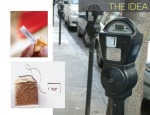When walking down 6th Avenue between Waverly Place and West 8th, I quickly took notice to the vendors selling on the street. It was a late fall day, and it was definitely on the cusp of rain. The men began to tarp the goods and the carts of umbrellas began to come out, then I began to wonder– these vendors need shelters, shelters that the stores have behind them. When I thought about it, these people here have a very simple and unadulterated business where design is non-existent. There’s no false sense of product identity– all these people need are the basics. With that in mind, and adapting Bryan Bell’s project’s to intervene based on individual need, I took on to grasp the fundamental needs of people, which led me to review Maslow’s Hierarchy of Needs. The environment in which these vendors are situated do not have access to fundmental shelter and homeostasis, thus I conceptualized a shlter which can provide coverage for a less-than-perfect day, business can continue, the business owner (and the business owner’s goods) can stay dry, a heated glass plate can provide a bit of warmth for passerbys and the owner on a chilly day. Simple, Shelter.
THE PROBLEM: This block, a popular site for transit and rushed pedestrians, has no spaces to sit down and rest. With a myriad of “on-the-go” stores and restaurants, it is easy for inhabitants to feel stressed and rushed. Passerbys forget to “stop and smell the roses,” and in exchange for quick commutes and easy accessibility, lose some positive energy.
THE THOUGHT: I was brainstorming ways in which objects of the past relayed ounces of positivity to their user, while trying to contextualize it in a sidewalk environment.
THE INTERVENTION: The Positicker (Posi=Positivity, Ticker) is a device that resembles a deli ticket counter, in which passerbys can grab as many tickets as they see fit. On the tickets are quotes, anecdotes, stories, short poems and other uplifting messages to promote positivity and relaxation among its users. If it’s a really bad/rushed day, one might consider taking several tickets before getting on the subway so that by the time they arrive at their destination, their spirits are lifted. The tickers will be placed on every third of the block, and suggestions for content may be submitted online.
My street is Christopher street between 7th avenue south and Bleecker street. I thought it was important to redirect the hierarchy on the street between the cigar shop and the sex shop by pointing out the hazards of the upper class activity of smoking cigars. I proposed that there would be a permanent billboard directly above the cigar shop that would be a diseased lung smoking a cigar so that people could see the direct health hazards of smoking before they enter the store. This would make people view the cigar store as not being more upper class than the sex shop, and that the cigar shop is actually less attractive and consequently bad for one’s health.
A Transnational Community Board
The Problematic Cultural Dynamic:
– Lack of active global flow of ideoscapes and mediascapes
– A static, inert quality
– Lack of a manner of community discourse and connection
The Design Element’s Effect
– Through media, migration can be observed & generate an awareness of transnationalism
– Bringing an arena for flow
– Transnational communication is uniting in a heterotopic manner, as it displays culture in a generic sense as well as a differential one


Please keep in mind guys, I am not a designer! Sorry my designs look like a kindergarten student did them.
From GaRam Han
Centered within the heart of the West Village, many of the buildings resemble old 19th century brownstones, giving them a type of old age history and feel which seem to resonate throughout the entire block. Residences of this neighborhood also seem to be dwelling in high C culture. A vacant store is where I plan my design intervention, where a General Store would be appropraite, reflecting many of the stores that are already on the block.
Before:

After:
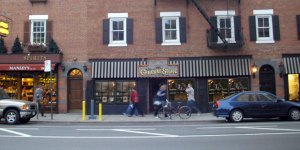 Closeup:
Closeup:

The street I chose is largely residential, except for a Lesbian, Gay, Bisexual, and Transgender Center that exists, nestled between the St. Vincents Hospital parking lot, and a row of brownstones.
This Center explores the concept of Generic versus Hierachical culture. It’s meant to be an inclusive place of community for people of all gender identities. In the area, there are changing mediascapes, financeoscapes, and ideoscapes.
There is also a difference of small “c” versus large “C” culture, in a place with old, traditional buildings and a quiet atmosphere (large “C”), being almost intruded on with these new ideas of culture (small “c”).
Love, Andrea
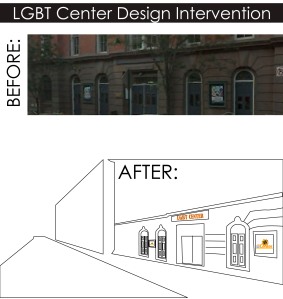
Douglas Crimp discusses postmodernism as an “anything goes” attitude that extends beyond the production to include the process of viewing art as well. Similarly, the Museum of Jurassic Technology challenges the traditional idea of a museum. If you visit, it is likely you will be the only one in there– giving you the experience of private tour of the museum. The MJT almost has a complete disregard for the traditional methods of museum authority- meticulous presentation, exhaustive captions, hushed lighting, and state-of-the-art technology (heating, lighting, security). David Wilson (founder and director) explained to Lawrence Weschler on his first visit that: “We’re definitely interested in presenting phenomena that other natural-history museums seem unwilling to present.”


Connections can be made to the work of Dunne and Raby in critical design, which asks people to view things in a new or unexpected way. Museums such as the Met or the Natural History Museum can be compared to affirmative design. That is, they conform to the general publics idea of what a museum should be, there is a natural order and a familiarity to the experience of visiting those museums. Even the Museum of Natural History that presents the so-called wonders of history- but it does so in a very linear fashion that mimics the textbooks we read in elementary school- dinosaurs, whales, monkeys… even the oddest of exhibitions are “normalized” by the familiar experience of entering an established institution.
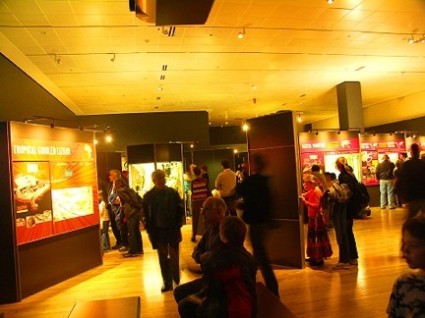
But like critical design, the MJT acknowledges the other possible histories. Raby suggested that critical design aimed to push the limits of the lived experience—I would say that is exactly what the MJT is doing. At the very least, it is certainly a conversation starter. Raby further suggests that “We don’t have to actually use the proposed products ourselves, it is by imagining them being used that they have an effect on us… a slight strangeness is key.” They are designed to provide mental pleasure and stimulate the mind—as are the exhibitions at the MJT.
“Distinctive features of the new cultural politics of difference are to trash the monolithic and homogeneous in the name of diversity, multiplicity and heterogeneity; to reject the abstract, general, and universal in light of the concrete, specific, and particular; and to historicize, contextualize and pluralize by highlighting the contingent, provisional, variable, tentative, shifting, and changing”.
This idea of “new cultural politics of difference” is to prove to those who believe in a homogeneous society, that diversity is real, and that it is present. It attempts to crush generalizations based on difference but promote and teach the history and background of what constitutes difference by highlighting it’s prevalence and the changing times.
What constitutes difference?
Exterminism, empire, class, race, gender, sexual orientation, age, nation, nature & region.
To break down the idea of difference makes it apparent that it is much more than skin deep and difference lies between any two individuals, of the same race or not.
Certain challenges are faced by the new cultural politics of difference, those being the intelectual challenge, the existential challenge, and the political challenge. To be able to see past the political and historical past of race is key in moving forward in the changing society.
The new cultural politics of difference evokes creative responses to the precise circumstances of our present moment.
“Distinct articulations of talented (and usually privileged) contributors to culture who desire to align themselves with demoralized, demobilized, depoliticized and disorganized people in order to empower and enable social action.
There can be no artistic break through or social progress without some form of crisis in civilization.”
Influential people of the world, spectators and artists alike, have become involved in helping to enable social actions by connecting and working with those less fortunate, giving them a voice, though creating.
The diaspora of minorities may be prevalent but because of these actions, they are not going unnoticed or forgotten
below are examples of various creative responses from the art industry, from fashion advertisements to illustrations
Using Personal and Collective Cultural Memory in Graphic
Storytelling

The cover of Incognegro by Mat Johnson / photo of Mat Johnson
“How do we use the visual imagery of the past to inform contemporary work in ways that build on our understanding of our history and our present?”
Mat Johnson’s graphic novel, Incognegro is the story of a fair-skinned African-American man living in Harlem during it’s Renaissance in the 1930’s. Thanks to his more European looking complexion, Zane Pinchback, is able to go undercover as a caucasian man to the lynchings still taking place in the Jim Crow south. Writing about the lynchings for his New York based newspaper, Pinchback is famous as “Incognegro”, the name playing off the idea that he is able to infiltrate the white community thanks to his genetics.
Throughout the first part of Incognegro, Johnson references visual imagery from the time period these lynchings were actually taking place. Most recognizable are his references to lynchings photos. In most instances, lynching photos were used as souvenirs of the event and to boost feelings of white supremacy.
The first panel of Johnson’s graphic novel almost directly refers to this photograph. In both images, a white man stands between the camera and the victim pointing towards the body. Even the date the photo was taken is important. On the first page Pinchback observes that “Between 1889 and 1918, 2,522 negroes were murdered by lynch mobs in America. That we know of. Now, since the beginning of the ’30’s, most of the white papers don’t even consider it news.” Incognegro a way for Mat Johnson to tell a forgotten but vitally important story about America’s history that is often forgotten. Maybe if we can’t bring ourselves to look at the actual evidence of the crime, Mat Johnson can show it to us in a different but still unsettling format.
Examples:

- Part 1, Page 1 of Incognegro

- The Lynching of Thomas Shipp and Abram Smith. August 7, 1930. Marion, Indiana

- Part 1, Page 2 of Incognegro
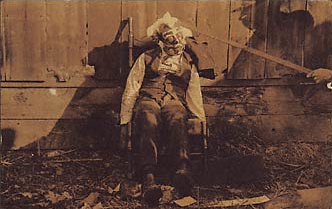
- Unidentified victim, head being propped up by rod
Legal scholar, Patricia J. Williams wrote: “The history preserved in those pictures, as well as the reality of the photos themselves, is one of the most complicated public secrets of this nation’s past. Everyone claims to know about lynching, yet there is virtually nothing about it in history or social-science books.” Mat Johnson seems determined not to allow us to forget this part of our past culture in fear that history will repeat itself.
While Johnson speaks about our history’s past, he also speaks about it’s present. In a series of frames later in the graphic novel the reader watches as Pinchback assumes his caucasian costume. Donning a suit and straightening his hair back, he becomes Incognegro; an act he calls “assimilation as revolution”. On the following page Pinchback speaks of America’s feelings of race, still an important discussion today; “Race is just a bunch of rules meant to keep us on the bottom. That’s what white folks never get. They don’t think they have accents. They don’t think they eat ethnic foods. Their music is classical. They think they’re normal. That they are the universal, and that everyone else is an odd deviation from form.” Johnson is pointing out the difference of an idea of the collective “American culture” and the multiple personal cultures that actually make up the United States of America.
In an interview from Racialicious, a blog about “the intersection of race and pop culture”, Mat Johnson speaks specifically to personal and collective cultural memory in his work:
Mat: It just seemed like a natural story to tell. And I always wanted this hero to be out there. Someone just like me, who turned what many see as an oddity into something priceless < Personal Memory
Racialicious: There’s been a long tradition of passing stories in American Literature (and pulp fiction). How do you see Incognegro fitting into that tradition, if at all?
MJ: Right. And Passing narratives were in their height with Nella Larsen in the Harlem Renaissance. And of course they go before that to the 19th Century slave narratives. Yes, this fits within that literary mythology. < Collective Cultural Memory
MJ: There’ve been other points in history – I’m African-American, but I look fairly white or European, so I’ve always been very fascinated by these points in history, when people like myself interacted, sometimes for better and sometimes for worse. I was fascinated with the idea of taking something that is part of my life and part of past lives, and seeing if I could make that into not just a curiosity, but into something that actually could mean the difference in lives.
More examples of a graphic novels that builds on our understanding of our past and present:

- “Loosely using the story of George Bush as an inept superhero, we chronicle the first four years of the Bush II administration, as well as his past and family history.” By Joshua Dysart

- Haunted Tank by Frank Marraffino. In the 2008 version of this classic series, the ghost of a Confederate general returns to guard over his living namesake who is stationed in Baghdad during the Iraq War.
For more information on the research and development of the Unknown Soldier including images and videos from Uganda go to: http://www.theunknownsoldiercomic.com
“Beyond Nostalgia” and “For the Love of Things” – Hella Jongerius
“On Beauty and Being Just” – Ellen Scarry
Jongerius channels Appadurai’s concept of ersatz-nostalgia when she claims that all sorts of artists, musicians and designers are using ‘traditional’ techniques in comtemporary settings. However, contrary toAppadurai, Jongerius suggests that we find beauty in tradition, not just as a marketing ploy, although she does state that “Trends are consigned to the grave almost before they are properly born.” Jongerius acknowledges that we use modern technology to re-create the past, as well as re-create traditional techniques in order to best produce things that look and feel traditional. We do so out of a desire for the past that is accessible to us NOW, and we are doing it in a way that is accessible to all.


Jongerius and Scarry agree tha we as human beings assign meaning and value to things based on our own personal experiences, our place in the world or global community, and our perception of these things qualifies as a summation of said experiences. For Scarry, we experience a ‘radical decentering’ when we see something beautiful; in other words, we become self-less and realize on an individual basis, that ‘I’ is not relative, but instead a small element within a grand design, so to speak. Jongerius says, “My perception of the world, whether physical or virtual, is largely dependent on my physical “being in the world.””

Jongerius goes on to suggest that while we currently do find beauty in things, and we attempt to re-create that beauty using modern techniques, these things we create are inherently short-living objects. Their ephemerality, however, is based out of our perception of their qualitative value, not their physical characteristics. She uses cell phones as an example. Although a cell phone, once produced, will work for years, newer and more advanced models come out almost as quickly as they are thrown away. Humans indulge in the newer models, throwing away the ‘old’ ones, making the value of the first cell phone obsolete, and replaceable. Again, she channels Appadurai and his concept of fashion marketing using “retro” styles, promoting the idea that we should buy now before our stlyes become obsolete.




